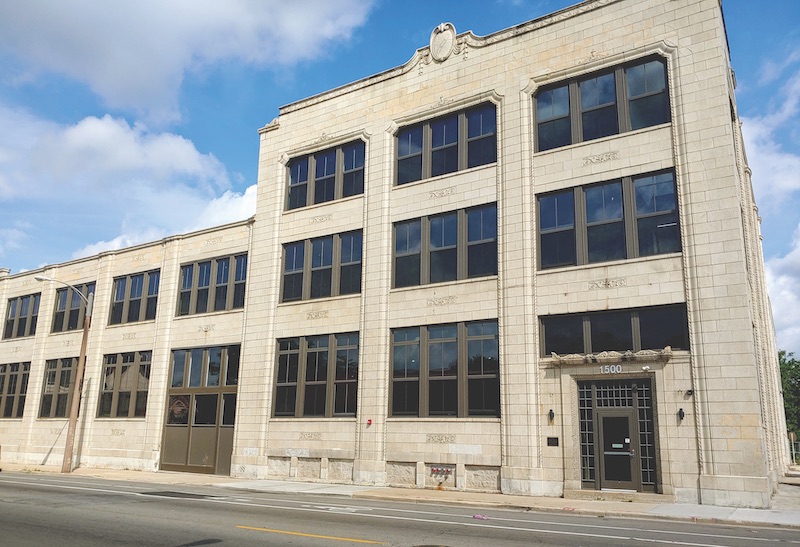David Block fell in love with the Blommer Ice Cream Company factory the nanosecond he first saw it, seven years ago. Block, an architect, city planner, and Director of Development with Evergreen Real Estate Group, Chicago, was on a scouting mission to Milwaukee to scope out development opportunities.
“It really caught my eye,” he recently recalled, as we gazed at the building from across North Avenue. “All the beautiful windows were blocked up, but it had a presence that called to me. I knew immediately that I wanted to do something with it.”
Block soon heard about Sally Peltz, Founder (now Board Member) of the nonprofit Legacy Midwest Renewal Corporation. “We were looking for a stellar project for workforce housing for the neighborhood,” said Peltz, a Milwaukee native and activist. In short order she and Block formed an alliance to convert the three-story industrial structure into much-needed rental housing.
It took a dedicated project team six years to pull off, but last December, Legacy Lofts began leasing its 64 apartments, 54 of which were set aside for families below 60% AMI, including 16 for the homeless. Legacy Lofts is now 100% occupied and, as we shall see, has become a beacon of hope for the struggling Lindsay Heights neighborhood.
But first, let’s time travel back a century and a half and meet Conrad Blommer.
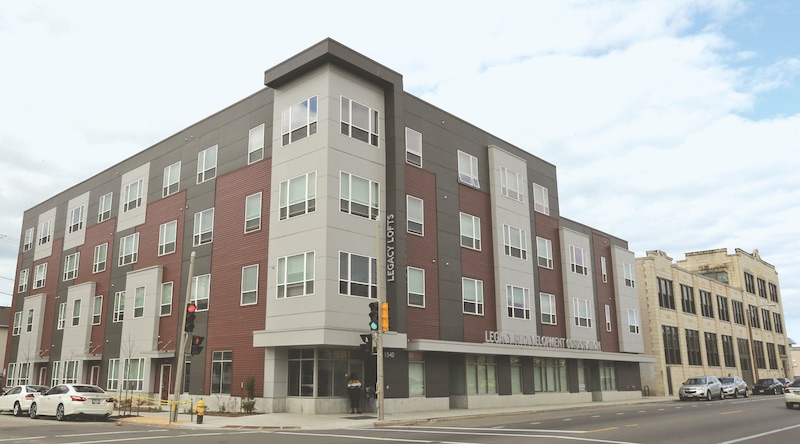 The addition to the original Blommer factory, Legacy Lofts. Photo: Tricia Shay.
The addition to the original Blommer factory, Legacy Lofts. Photo: Tricia Shay.
AN ENTERPRISE BUILT ON ICE
Conrad Blommer (pronounced “Blummer”) opened his first candy store and ice cream parlor in Milwaukee in 1870. Forty years later, he built a small ice cream plant at 15th Street and North Avenue. By the early 1920s, with the addition of four factories in Wisconsin, his company was producing half a million gallons a year—8% of all the ice cream made in the state.
To keep up with demand, Blommer commissioned local architect Vernon H. Esser (1891-1970) to design an addition several times larger than the original plant. Esser’s design stressed what he called “the advertising value of beauty and sanitation in industrial buildings.” Completed in 1927 and outfitted with the latest equipment, the two- and three-story factory, clad in cream-colored terra cotta and Italian Renaissance detailing that combined cleanliness with delicacy, began producing ice cream products that were “practically untouched by human hands.”
Not long after the new factory was completed, however, Blommer Ice Cream merged with two other dairies to form Wisconsin Creameries, which operated the plant until 1934. By 2012, when Block happened upon it, the factory had been vacant for decades. It would take six years for Block and Peltz to realize their vision for the property.
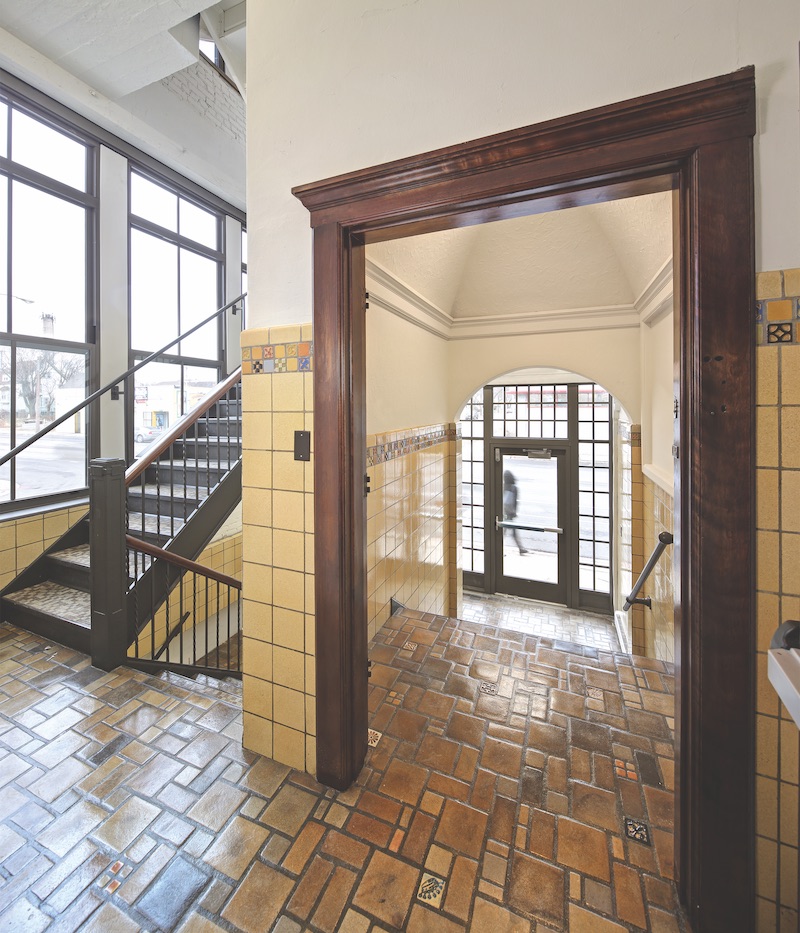 The entry vestibule and stairs feature period floor tiles and tile wainscoting accented with small tiles that purportedly described the many flavors of Blommer ice cream. The State Historic Preservation Officer stated the rehabilitation “successfully incorporated” the entryway and tiles. Photo: Tricia Shay.
The entry vestibule and stairs feature period floor tiles and tile wainscoting accented with small tiles that purportedly described the many flavors of Blommer ice cream. The State Historic Preservation Officer stated the rehabilitation “successfully incorporated” the entryway and tiles. Photo: Tricia Shay.
OVERCOMING STRICT REGULATORY DEMANDS
Financing for the $13.8 million reconstruction of the 45,000-sf Blommer building and 32,000 sf of new construction hinged on getting historic preservation tax credits. MacRostie Historical Advisors guided the application through the State Historic Preservation Officer and the National Park Service (NPS) to get the Blommer plant deemed “locally significant” under the National Register of Historic Places (Criterion A) in late 2017.
The Wisconsin Housing and Economic Development Authority (WHEDA) provided $7.7 million in low-income housing tax credits and an $8.5 million construction loan. Additional funding came from IFF and the Federal Home Loan Bank’s Affordable Housing Program. The project gained a total $2.8 million in historic tax credits. Associated Bank bought the state credits; US Bank bought the federal credits. The city contributed $690,000 in HOME funds and $635,000 through a developer-financed TIF district.
“The multiple layers of financing that allowed this project to go through were very strict in their requirements,” said lead architect Falamak Nourzad, NCARB, AIA, LEED AP, ASID, Principal, Continuum Architects + Planners, a local MWBE design firm with a lengthy record of historic renovations in Milwaukee. “WHEDA dictated that the units had to be a certain size. HUD [U.S. Department of Housing & Urban Development] has guidelines that are well above ADA. And you have to deal with the National Park Service, especially on the exterior.”
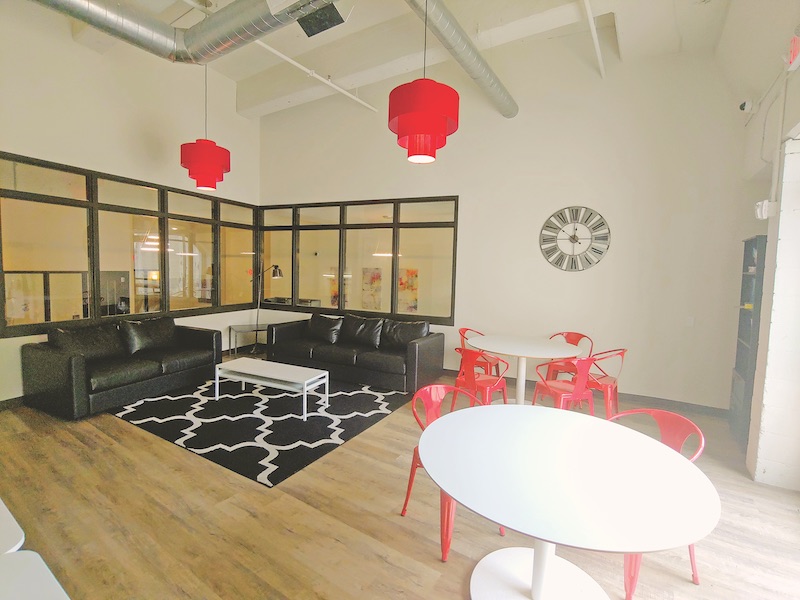 A 450-sf library and multipurpose community room was carved out from the old loading dock. “It gets busy in the afternoon with families and kids reading and doing homework,” said Xavier Shands, On-site Property Manager, Evergreen Real Estate Group. Photo: Roziel Reyes.
A 450-sf library and multipurpose community room was carved out from the old loading dock. “It gets busy in the afternoon with families and kids reading and doing homework,” said Xavier Shands, On-site Property Manager, Evergreen Real Estate Group. Photo: Roziel Reyes.
To meet NPS’s historic preservation requirements, the 26-unit contemporary addition was stepped down from four stories at the western corner to three stories adjacent to the Blommer building. “That cost us a few units, but it worked out in the end,” said Nourzad.
The Wisconsin Historical Society, which acts as the State Historic Preservation Officer, stated, “As a general rule, new construction cannot exceed the height of the historic building. However, a compromise was reached where only the portion closest to the historic building had to be reduced one floor in height and the remaining portions could remain taller.”
Continuum Principal Michael A. Soto, NCARB, AIA, said that, while the Blommer building was structurally sound, the project team took pains to be careful with the terra cotta. “It really is a timeless material,” he said. He commended the NPS and other authorities for being “really willing to listen and work with us.”
See Also: Techno-magnet: Proto Kendall Square
The contemporary design of the new section was purposeful in its intent. “We wanted to be respectful of the old building, but copying it was something that neither we nor the NPS wanted,” said Nourzad.
To overcome a four-foot grade difference in the historic building that made ADA accessibility hard to achieve, Continuum and the contractor, Greenfire Management Service, took advantage of the building’s existing internal grade difference to create a double-height lobby; a resident library/game room overlooks the lobby. The project team was then able to modify the elevator to stop at the lower level for ADA compliance.
The project team outfitted Legacy Lofts with amenities that defy its “primarily affordable” label: a library/community room, the spacious lobby, individual storage, some off-street parking, in-unit washers and dryers, ceiling heights that go up to 20 feet, polished concrete floors, and beautifully restored windows, many as tall as 10 feet.
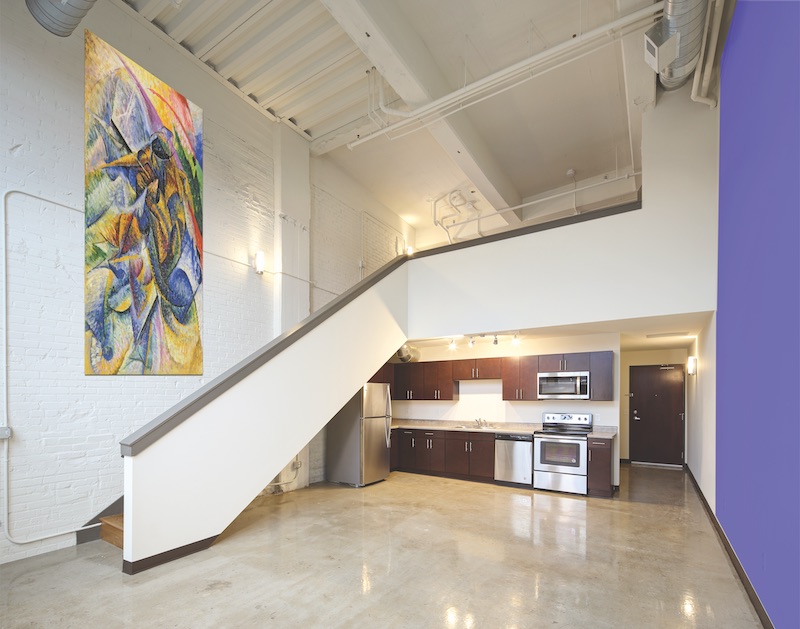 Apartments in Legacy Lofts range in size from 500 to 1,600 sf. Townhomes in the new addition measure 1,200 to 1,400 sf. Units have generous ceiling heights, as much as 20 feet in some cases. Legacy Redevelopment Corp., the lending arm of co-developer Legacy Midwest Redevelopment Corp., has an office in the new construction portion of Legacy Lofts. Photo: Tricia Shay.
Apartments in Legacy Lofts range in size from 500 to 1,600 sf. Townhomes in the new addition measure 1,200 to 1,400 sf. Units have generous ceiling heights, as much as 20 feet in some cases. Legacy Redevelopment Corp., the lending arm of co-developer Legacy Midwest Redevelopment Corp., has an office in the new construction portion of Legacy Lofts. Photo: Tricia Shay.
THE POWER OF POSITIVE THINKING
Does the success of Legacy Lofts signal a turnaround for Lindsay Heights? The neighborhood, founded by German immigrants, was once a stop in the Underground Railroad. Russians and Poles followed, to be succeeded by African-Americans.
Today, African-Americans comprise 87% of Lindsay Heights residents, versus 39% citywide. Nearly half of its households (46%) live below the poverty level (29% citywide); 40% are headed by single women (22% citywide). Two-thirds of the housing stock (66%) was built before 1940 (37% citywide).
“This has been a distressed area for a long time, but the resurgence of downtown is coming up all the corridors,” said Peltz. The city is “very concerned,” she said, about making sure the neighborhoods get their share of new development—“not just the gentrified areas near Lake Michigan.”
As evidence of this resurgence, she cited last year’s opening of the nearby Fiserv Forum, the new $524 million home of the NBA Milwaukee Bucks, where the Democratic Convention will be held next July (Milwaukee beat out Houston and Miami Beach for the honor), and local developer Haywood Group’s plans to turn the vacant Sears store six blocks west of Legacy Lofts into an 80-key Ikon Hotel.
Then there’s the renovation of the historic Walter Schmidt Tavern into Tandem, a popular new restaurant; institutions like the Innovations and Wellness Commons and Walnut Way, nonprofits that promote wellness and neighborhood development; and Lindsay Heights’s designation as Milwaukee’s first “ECO-Neighborhood.”
As Peltz told me, Legacy Lofts is yet another symbol of “the tremendous growth and new branding of Milwaukee.”
Related Stories
| Mar 22, 2011
Mayor Bloomberg unveils plans for New York City’s largest new affordable housing complex since the ’70s
Plans for Hunter’s Point South, the largest new affordable housing complex to be built in New York City since the 1970s, include new residences for 5,000 families, with more than 900 in this first phase. A development team consisting of Phipps Houses, Related Companies, and Monadnock Construction has been selected to build the residential portion of the first phase of the Queens waterfront complex, which includes two mixed-use buildings comprising more than 900 housing units and roughly 20,000 square feet of new retail space.
| Mar 17, 2011
Perkins Eastman launches The Green House prototype design package
Design and architecture firm Perkins Eastman is pleased to join The Green House project and NCB Capital Impact in announcing the launch of The Green House Prototype Design Package. The Prototype will help providers develop small home senior living communities with greater efficiency and cost savings—all to the standards of care developed by The Green House project.
| Mar 11, 2011
Renovation energizes retirement community in Massachusetts
The 12-year-old Edgewood Retirement Community in Andover, Mass., underwent a major 40,000-sf expansion and renovation that added 60 patient care beds in the long-term care unit, a new 17,000-sf, 40-bed cognitive impairment unit, and an 80-seat informal dining bistro.
| Mar 11, 2011
Mixed-income retirement community in Maryland based on holistic care
The Green House Residences at Stadium Place in Waverly, Md., is a five-story, 40,600-sf, mixed-income retirement community based on a holistic continuum of care concept developed by Dr. Bill Thomas. Each of the four residential floors houses a self-contained home for 12 residents that includes 12 bedrooms/baths organized around a common living/social area called the “hearth,” which includes a kitchen, living room with fireplace, and dining area.
| Mar 11, 2011
Texas A&M mixed-use community will focus on green living
HOK, Realty Appreciation, and Texas A&M University are working on the Urban Living Laboratory, a 1.2-million-sf mixed-use project owned by the university. The five-phase, live-work-play project will include offices, retail, multifamily apartments, and two hotels.
| Mar 1, 2011
How to make rentals more attractive as the American dream evolves, adapts
Roger K. Lewis, architect and professor emeritus of architecture at the University of Maryland, writes in the Washington Post about the rising market demand for rental housing and how Building Teams can make these properties a desirable choice for consumer, not just an economically prudent and necessary one.
| Feb 15, 2011
New Orleans' rebuilt public housing architecture gets mixed reviews
The architecture of New Orleans’ new public housing is awash with optimism about how urban-design will improve residents' lives—but the changes are based on the idealism of an earlier era that’s being erased and revised.
| Feb 11, 2011
Chicago high-rise mixes condos with classrooms for Art Institute students
The Legacy at Millennium Park is a 72-story, mixed-use complex that rises high above Chicago’s Michigan Avenue. The glass tower, designed by Solomon Cordwell Buenz, is mostly residential, but also includes 41,000 sf of classroom space for the School of the Art Institute of Chicago and another 7,400 sf of retail space. The building’s 355 one-, two-, three-, and four-bedroom condominiums range from 875 sf to 9,300 sf, and there are seven levels of parking. Sky patios on the 15th, 42nd, and 60th floors give owners outdoor access and views of Lake Michigan.
| Feb 11, 2011
Sustainable community center to serve Angelinos in need
Harbor Interfaith Services, a nonprofit serving the homeless and working poor in the Harbor Area and South Bay communities of Los Angeles, engaged Withee Malcolm Architects to design a new 15,000-sf family resource center. The architects, who are working pro bono for the initial phase, created a family-centered design that consolidates all programs into a single building. The new three-story space will house a resource center, food pantry, nursery and pre-school, and administrative offices, plus indoor and outdoor play spaces and underground parking. The building’s scale and setbacks will help it blend with its residential neighbors, while its low-flow fixtures, low-VOC and recycled materials, and energy-efficient mechanical equipment and appliances will help it earn LEED certification.
| Feb 11, 2011
Apartment complex caters to University of Minnesota students
Twin Cities firm Elness Swenson Graham Architects designed the new Stadium Village Flats, in the University of Minnesota’s East Bank Campus, with students in mind. The $30 million, six-story residential/retail complex will include 120 furnished apartments with fitness rooms and lounges on each floor. More than 5,000 sf of first-floor retail space and two levels of below-ground parking will complete the complex. Opus AE Group Inc., based in Minneapolis, will provide structural engineering services.


